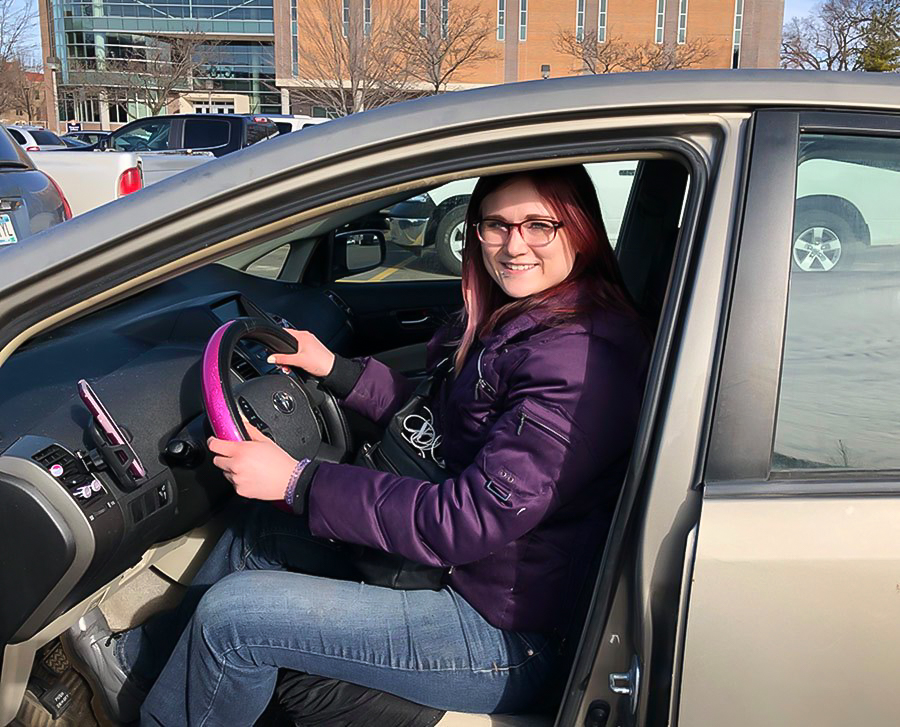Lyft makes its first appearance in Winona
CONTRIBUTED PHOTO BY HANNAH HIPPENSTEEL
Lex Lea, a Winona State junior, poses in the driver’s seat of her Prius that has served as her vehicle of choice for the past six months as a Lyft driver. Winona didn’t have Lyft until 2018, a direct driver-to-rider, cashless car service controlled solely by cell phones.
February 26, 2020
For residents of Winona, Minnesota, there are many ways to get from a person’s point A to point B.
The city offers a four-route shuttle bus system, a taxicab company and a recreation center equipped with canoes, rollerblades and bicycles.
If all else fails, a stroll can get someone almost anywhere downtown or otherwise commercial in about 20 minutes.
One thing Winona did not have until 2018 was Lyft, a direct driver-to-rider, cashless car service controlled solely by cell phones.
The service becomes available in cities that have a desire for it; for Winona, this means it falls within the Greater Minnesota area which also services cities extending from Red Wing to Albert Lea.
The first step in the Lyft process is to create a rider or driver profile.
Once the profile is created, users input a debit or credit card which allows money to be withdrawn as a rider and deposited as a driver.
From there, riders can type in their point for pick-up and drop-off.
What happens next?
The driver who is nearest to the rider’s current location will be on their way to the designated pick-up point.
In terms of the driver side of this process, they receive stickers to mark their vehicle once certified.
As time goes on and more rides accumulate, the drivers will then receive an elevated status in their car: a light-up sign to display in the front window.
While the idea of getting in a stranger’s vehicle may make some uneasy, Lyft implemented the ability for riders and drivers alike to watch a digitized progression of the ride.
Lex Lea, a Winona State University junior, jumped at the chance to join Lyft this past summer and make money doing an enjoyable task for her: driving.
She has been a driver with Lyft for six months. Lyft ran a background check, driver’s record check and confirmation of her license and insurance.
She also has enjoyed the chance to make her rides more personable by decking her car ceiling out with collectible pins and buttons.
“This creates a way for less talkative riders to occupy their time and it’s also a good conversation starter for the chattier riders,” Lea said.
Every element of the application is approved individually. Drivers cannot begin until all parts have passed Lyft’s driver screening.
Lea said Lyft periodically offers instructional videos to help prepare drivers to handle specific situations with riders.
While she likes Lyft for its flexible hours, Lea said she uses it for fast cash and not as her primary income. It can take a considerable amount of drives to make significant money, as the minimum rate starts at $3.64 and goes up per mile.
Part of the payment for her though is the entertaining riders. One of Lea’s favorite interactions came from a group of drunken girls who “hyped her up” by persistently calling everyone in the car, which included Lea, “on point and so pretty.”
“It’s interesting that drunk people always think that they’re found to be annoying by sober people. I don’t mind, though. It’s entertaining and much better than sitting at home,” Lea said.
Kaitlyn Tenney, a Winona State senior, started with Lyft in October as she saw her dad go through the process, which she described as “super easy.”
When Tenney drives, she said she prefers Thursday to Saturday nights until bar close around 1 a.m.
Unlike Lea, Tenney’s most interesting ride took a scarier turn.
Tenney had been driving to the St. Mary’s campus and was directed down an unmarked, gravel path around midnight.
She arrived and saw no house but instead a figure of a man right in front of her.
“It was terrifying. I whipped around and high-tailed it back.” Tenney said. “When I went back the next day, I saw it was just a decorative statue in the driveway.”
Despite drunken antics, Tenney said the service makes sense for Winona.
“It’s a useful service for the bar scene and convenient because almost everyone has a phone,” Tenney said.
According to Tenney, she has had riders who use it if they are unable to drive and need to get to work, pick up groceries and get to treatment groups.
As more people learn of the app, the service could potentially take Lyft-off as the primary mode of transportation in Winona.
The opinions expressed in this paper are not necessarily those of Winona State University, the Minnesota State Colleges and University system, or the Winona State University student body.



































